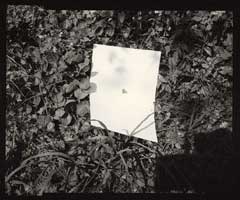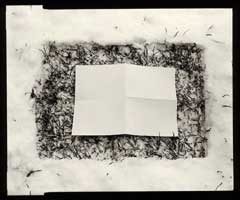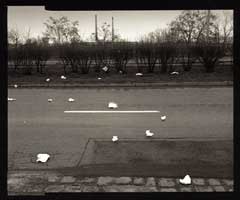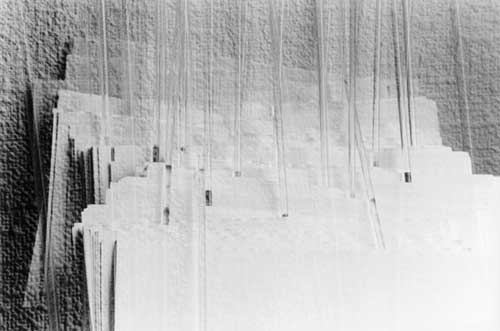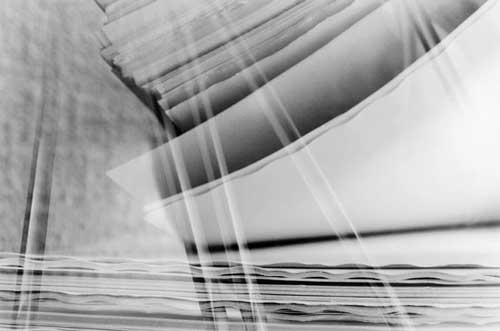from the Places of Memory series, 1998 - 2000
A PAPER PIECE OF MEMORY Douglas Davis says that: "...photography is best understood not as the aesthetic object but as the incorporeal picture hung in memory." This very rudimentary gist of photography - as a souvenir - is put both before and above art. It is important while watching souvenir photographs of a family scrapbook. It might also become the part of an artwork, which goes beyond purely artistic performance and informs about real existence of photographed people or circumstances. There have been photographers who - like Christian Boltanski or Jerzy Lewczyński - base their work, first of all, on this purely meaningful and non-aesthetic aspect of photography. In his Places of Nonmemory and Still Life of Memory series Andrzej P. Bator refers to photography understanding as a memory recording and also places his works as part of art - as part of an aesthetic message.
This attitude to photography is present in Bator's works at several interconnected levels. Though each of the series, and both of them as the whole of an exhibition, are governed by the concise and distinct concept-idea: reflection on memory nature and photography nature, they by no means follow premises of a conceptual sequence which includes a logical train of elements. A mutual relation between particular photographs is not in character with an exact train of mental studies, but with a loose constellation in which same problem is being watched from different angles and perspectives all in order to capture its multi-aspect nature. So constructed a series of photographs takes things more in the spirit of artistic ambiguity rather than a scientific discourse.
Additionally: each photograph - though is a part of a precise concept of the series - can become a separate overall work. It so happens because the author does not use photography as an aesthetically neutral conveyor of meanings. In fact he consciously makes use of formal features of the medium of photography to build a symbolic picture - the aesthetic object.
A white sheet of paper, a recurring theme of both series of photographs, is the key to their symbolism. It appears in contact prints from the Places of Nonmemory series and plays the role of a signal marking the presence of an observer, a witness in a deserted natural or industrial landscape. Against these surroundings, the sheet is a strange and alien element. Sometimes it gives the impression of an absurd object, for example, when it has been nailed to grass. Sometimes it awakes compassion and pensiveness when the sheet is found on the surface of a puddle - a dirty and unnecessary thing. And another time, intriguing and mysterious, placed on a dark brick raw wall, it becomes a sign of surprising and unexpected presence: like a fairy tower visible from this shabby court seems to be similarly amazing.
Places marked with an unwritten sheet are blank places "places of nonmemory". They do not have the meaning of their own; they have been registered as various circumstances that may happen during wanderings: places seen occasionally -only seen places and nothing more. The subject of these photographs, instead of a real person, is always a symbolic sheet of paper signifying an individual consciousness ready to record circumstances and events it meet on its way. It might happen that these recordings are - to describe this happening symbolically - crushed and crumpled like a sheet of paper and later hidden in a tight container: deep down the consciousness. Maybe another time in the future they will become an unexpected treasure.
Andrzej P. Bator reaches for different associations and symbols deeply rooted in collective memory: human culture. However, he does not want to leave the field to accidental and unconscious senses which might come into existence in a photograph due to an intuitive "taking a view" straight and direct from reality. In the Still Life of Memory even more distinctly than in the Places of Nonmemory, he has chosen conscious creation of an image. He evocates new reality: a specific set of objects through which he in a sophisticated way plots the light to build unusual symbolic spaces. Most obviously he is fascinated with the possibility to conjure up a fiction created on purpose for the use of photography. These are specific fictions that - paradoxically - really exist; it is camera's nature to register what really exists. Their double fantasy and reality nature enables to create a suggestive vision simultaneously probable and improbable.
In repeated expositions, there are born pictures made from dissolving sights. Here in front of our eyes, a photograph recreates the structure of human memory consisting of overlapping fragmentary images coming from different times and from different perspectives, sometimes bright and clear, another time diffused and illegible. An unusual phenomenon takes place: this what seems not to exist - because it is recorded only in memory - is being transformed into a real sight. And yet it really exists, it exists as photography, this photography which very deep down close to its roots is nothing more than only a paper piece of memory. And memory is nothing more than true reality of a human figure.
Placed in photographs, one on another, sheets of clean paper, waiting for writing on, are here an ambiguous symbol directing both to the nature of memory and the gist of photography. Same elements, each time differently succumbing to light, give compositions of very different dynamics, atmosphere, emotional expression. Their detailed symbolism - shown if not more in titles given by the author for his own use: Painful Realism, Philosophy I -IV, Absolute, Martial Law, Card Index, Dreams is of personal and hermetic nature; it has not to necessarily be understandable for the spectator. The images in photographs assume manifold forms which might be filled in with own feelings and associations set free by the suggestion of dazzle and rapture, gloom and fear or the opposite - peace and silence, all evoked by these photographs.
The photographs which constitute the Still Life of Memory acquire their ambiguous senses due to - to much extent - symbolism of objects used in compositions: apart from a sheet of paper, they include sticks (record, touch, division, interference) and a crystal ball (perfect quality - consciousness, fortune, other reality). Yet light is here of great importance. Light, skilfully plotted, can radically change an emotional expression and, thus, the kind of objects' symbolism. It is light which causes that while looking at a small "still life" set at a table, we rather perceive vast areas spreading up the image, built from several distances created by light and depth of field. Sights are so realistic that they seem to be the truest reality though they are only a setting conjured up in imagination for the use of photography.
Real sights recorded on contact prints from the Places of Nonmemory betray their true abstract nature as a set background for the presentation of an only real object - a white sheet of paper. While fictions from the Still Life of Memory set before a camera become real, saying thus that human memory is the only reality. Both series of photographs, when set together, become a counterpoint for each other and show how fiction and commonly understood reality change places if the spectator can enter true nature of the thing. Similarly like a sheet of paper imagined in a photograph is in fact only an abstract image of the sheet; the real object is a photograph: metaphorical and a truly paper piece of memory.
Elżbieta Łubowicz, March 2001

from the Still - life of Memory series, 1998 - 2000
Biographical information
Photography from exhibition
Copyright ©2001 Galeria FF ŁDK, Andzrej P. Bator, Elżbieta Łubowicz.



